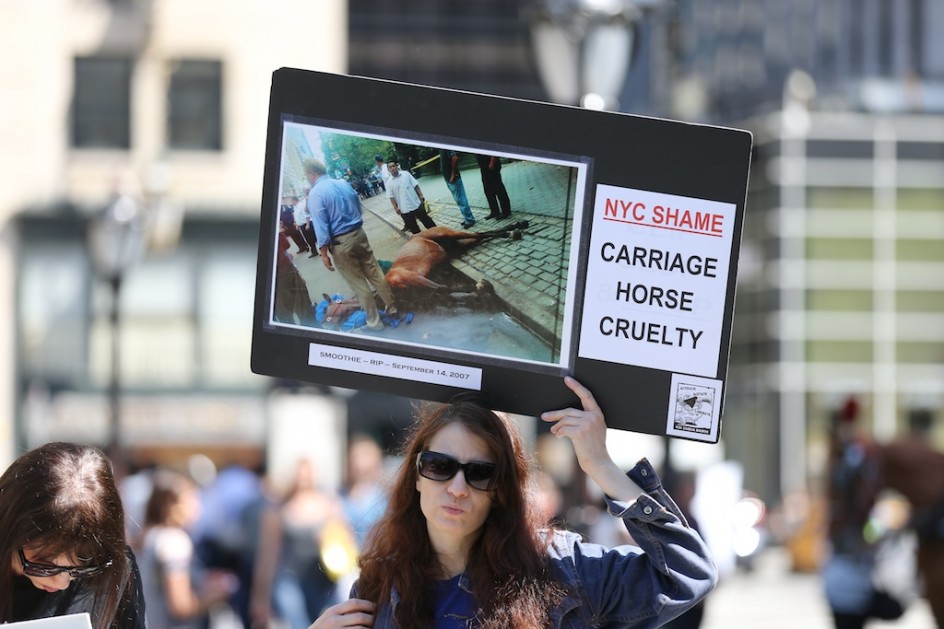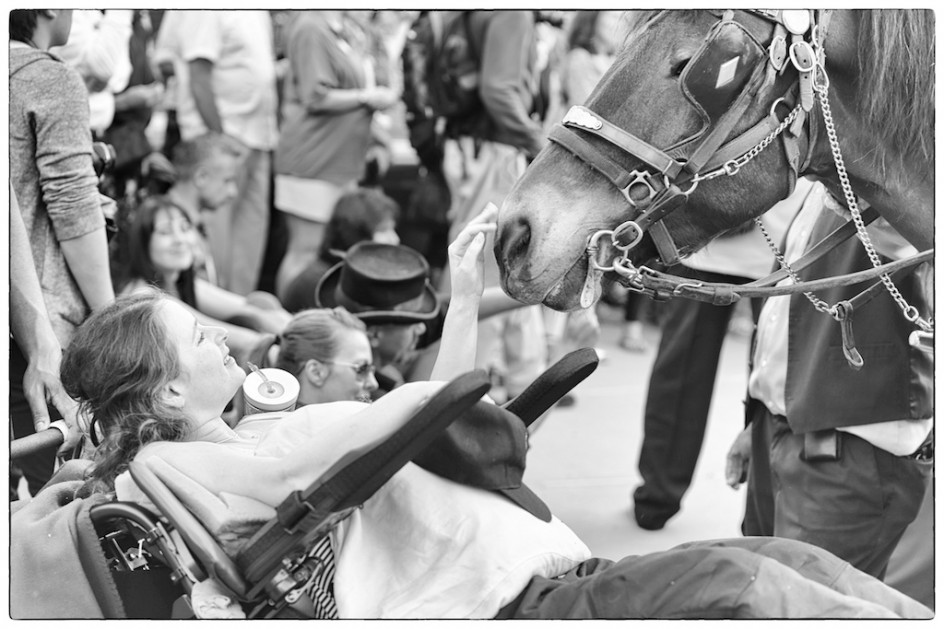
The New York Carriage Horse Drivers and scores of animal rights demonstrators have been staring at one another for years now, usually just a few feet apart. In these surreal confrontations – usually, the demonstrators are shouting at the drivers, who try and ignore them – they have never had any real contact with another. The carriage drivers are fascinated by the fact – they often talk of it – that, despite many offers and invitations, none of the demonstrators have ever touched a horse or come close to one. None has ever petted a horse, offered a carrot, or even come within a few feet.
I’ve seen this myself, and it is, to say the least, unusual for animal lovers to avoid any contact with the animals they are claiming to be saving.
For me, the carriage horse controversy offers an almost unprecedented opportunity – New York City is our greatest stage – to talk about issues like abuse, the future of animals in our world. That has not happened. From the first, the confrontation has been ugly, divisive and sometimes utterly irrational. The city’s mayor, who has refused to talk to the carriage owners or drivers or visit the horse stables, insists banning the horses is an urgent priority for him, he says there is nothing to discuss.
How sad, especially when the whole world is watching.
I encountered this last week when I approached one of the demonstrators near Central Park and asked to speak with her about the horses; I offered to sit down with her over a cup of coffee, I was curious to know more about how she felt, why she was out there with her sign. She did not want to talk to me. “I know who you are,” she said, “you are going on our Facebook enemies list. You support the abuse of horses.”
When the demonstrators come, they pass out a single page orange pamphlet entitled: “Is Cruelty On Your Sightseeing List?” There are eight points on the list. The first alleges that many of the stables are so small that the horses cannot lie down or properly rest or sleep. The last claims that “when the horses are no longer able to make money for the owners and drivers, many are sent to the auction block and slaughtered for use in pet food and meat consumption overseas.” The horses, says the pamphlet are shipped to slaughterhouses in Canada and Mexico under “terrible conditions.”
Over the next week, I plan to address each one of these claims, I want to write my own “truth” sheet about the horses, insofar as I can (and I will be honest when I can’t.) I want to take these points one at a time and talk about what appears to be true, and what is not. Facts are different from arguments and opinions. Abuse, for example, is not an observation, it is a crime with a specific meaning. When possible, I will look at facts.
I’ll start with the last point first. Number Eight.
To begin with, it needs to be said that the horses are slaughtered overseas because animal rights lobbyists successfully and thoughtlessly pressured Congress to ban slaughterhouses in the United States. This has resulted in an average of 155,000 horses a year being sent out of the country in sometimes horrific conditions. The carriage trade owners often retire their horses to their own farms, and carriage drivers themselves have created and funded a Blue Star Equiculture, a farm in Massachusetts created expressly as a place where retired carriage and draft horses can go.
Blue Star, like the carriage drivers, have been the subject of repeated attacks and protests because it supports the tradition of horses working with people.
Having said that, I should add that I am certain that the pamphlet is at least partially correct. Some of the retired carriage horses do end up in slaughterhouses. Everyone is not wealthy, especially in the carriage trade. It is not anymore possible for many of the people in the carriage trade to feed these horses for the rest of their lives than it is for the animal rights groups to claim that all of the 220 carriage horses will go to rescue farms if they are banned from the city. According to a recent story in the New York Daily News, that would cost about $20 million dollars.
In recent years, American’s relationships with animals have been emotionalized and personified beyond imagination and to a degree unprecedented in human history. The animal rights and rescue cultures have both advanced the idea that it is cruel and inhumane for any animal to be put to death for any reason. This has left countless thousands of dogs to spend their natural lives – years – in crates, in “no-kill” shelters as if that is a humane life for them. Aren’t there some instances where death is merciful, rational? The emotionalizing of animals has also led the claim – supported by the mayor of New York – that the only proper home for large working horses is a rescue farm.
We have lost all respect for death in America, when it comes to people, when it comes to animals. Millions of Americans languish in meaningless lives of suffering and disconnection because no one wants to face the reality of death or talk about it. The same has become true of animals. We have come to accept the idea that death is unacceptable in any form. The measure of our being humane is now long we can keep an animal alive, no matter what the circumstances.
It is an easy idea to embrace, and it has almost become the anthem of the animal rights movement, but it is an idea that is troubling in many ways and needs thoughtful discussion, of which there has been almost none, certainly not in New York. Since the demonstrators won’t talk to me, I’ll start a conversation right here.
__
Here’s some truth: If animals are to remain in our world; the people who keep them there, care for them and pay for their maintenance must have the right to euthanize them under certain circumstances. If I did not have the option of sending some of the animals on my farm to slaughter, then I would not be able to have them. I cannot afford to house, feed, water them and provide their health care under all circumstances for the rest of their lives.
There is only so much money I can spend on veterinary car, hay, fences, feed. I have only so much pasture, so much space in the barn. If one is not wealthy, this is true of almost everyone who owns and loves an animal in our world. Recently I had a ewe who lost a lamb, and I was flooded with messages pleading with me to adopt a lamb and bring one to her. The could not accept this loss for her; they could not accept the power and truth of the natural world, the world every animal comes from. I declined.
When human mothers lose their babies, they do not rush out and get another one. Life and death are blood brothers; they exist alongside one another. That is the very nature of life. Animals are our partners in the world, not just our piteous and dependent wards. By what ethical standard are we obliged to treat animals in a different or superior way than we treat ourselves or our fellow human beings?
Animals cannot be our equals, they require us to care for them and feed them. They cannot make choices about their own lives; they depend on us to make good ones for them. The standard is not keeping them alive at all costs by any means; the standard is doing as best we can for as long as we can. We need to keep animals in our world, and to understand the realities and limits of what that requires. This the mark of a true animal lover, we are called upon to be selfless, not selfish, we are called to think of what is best for them, not what makes us feel good about ourselves.
We can not guarantee every animal in the world a “no-kill” life in paradise, any more than we can guarantee that for ourselves and our children. If such a standard – and it is a standard being offered by the people banning the horses in New York – is adopted by governments and legislators, then animals will simply disappear. No one will be able to afford to keep them, no one but rich people will take the chance of acquiring animals they cannot get rid of. They will continue to disappear from our world, just as may be the fate of the carriage horses if the mayor and the animal rights organizations succeed.
Animals have accidents, just like us. They fall, just like us. They have heart attacks and strokes, just like us. Sometimes, they will be abused and mistreated, just like us. If every unfortunate incident involving an animal becomes a scandal or media sensation, then there will very soon be no animals to preserve or abuse, love or live with. There is no Utopia, no Nirvana, not for them, not for us.
Farmers cannot afford to keep animals alive forever who cannot work and earn money for them, they cannot be forced to keep animals alive beyond cost or reason or natural laws. Neither can I. Neither can you. That is what’s at stake in the carriage horse debate. If these horses are driven away for these reasons in this manner, we will all soon be standing in the shoes of the carriage owners and drivers. Their fight is the fight of every person who loves animals and wants them in our lives.
Death cannot be fantasized or eliminated from the human-animal equation. It is always there, it must always be faced.
The horses are the perfect symbol of the lack of perspective and reality that has come to dominate elements of the rescue and animal rights movement and is now spreading to the political spectrum. The horses are not abused. They are well cared for, safe, fed and sheltered, they are among the most regulated – and luckiest – animals in the world. If they can only live lives where they must never fall, get sick, get injured or – yes, even sent to slaughter – then the animal rights demonstrators can pack up and go home. Their work will be done.
There will be no horses anywhere for them to demonstrate about. Their only right that they will have won is to fade from our consciousness for good. And from Mother Earth. Just ask the Native-Americans, they have seen it all before; they were right there.
As to Orange Pamphlet Point Number Eight: It would be a great boon to the horses if the animal rights movement would drop its opposition to slaughterhouses in the United States, they were far more humane and regulated than the places the horses are now being sent. These mindless notions about what is good for animals are not helping them, they are must making it more difficult to keep them with us.
Reading this pamphlet helps me understand the demonstrators I see screaming at the horses and the drivers every week. There is a powerful disconnection about them, they seem far removed from the animals whose rights they are claiming to be protecting.
Next: Can the horses turn around in their “filthy” stables?

